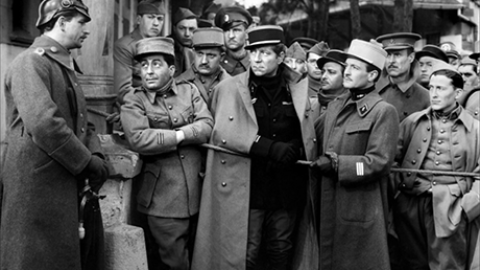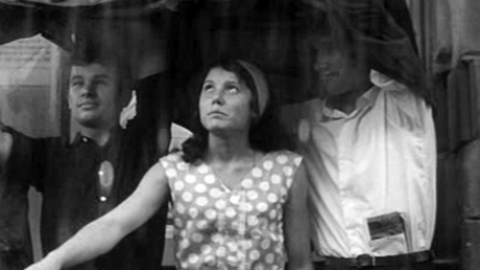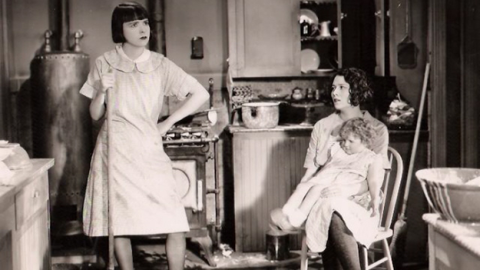Festivals: Il Cinema Ritrovato
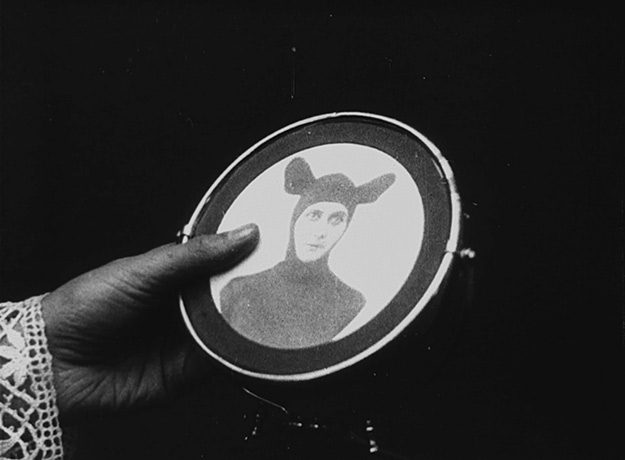
Les Vampires
One of the reliable highlights of Bologna’s Il Cinema Ritrovato festival is its slate of centennial programs. While the major American productions—The Birth of a Nation and The Cheat—were missing from the 1915 lineup, there was a new digital restoration of Louis Feuillade’s serial Les Vampires (1915-17), with episodes playing daily, and with heroine Irma Vep adorning the official tote bags. This year also marked the hundredth anniversary of Technicolor, and the festival’s many archival partners dug deep into their vaults to pull out gorgeous vintage prints, including The Thin Red Line (98), shown in a unique dye-transfer print at the 10,000-seat open-air Piazza Maggiore—which remained packed for the entire 170 minutes—and All That Heaven Allows in a 1956 international distribution print with French and Dutch subtitles. Sirk’s Hudson-Wyman melodrama was presented by Nicola Mazzanti of the Royal Belgian Film Archive, who concluded his remarks by proudly bellowing: “Technicolor is like God. It cannot be copied.”
Even the most beloved of classics require restoration and care, and for lesser or unknown works, the situation is all the more dire. These are films lucky for having survived at all, whether in the form of archival deep-dive finds, rediscovered footage, or “lost” films unearthed from mislabeled canisters or recovered in a fortuitous donation. Il Cinema Ritrovato, which is connected to the Cineteca di Bologna and L’Immagine Ritrovata, a major film restoration laboratory, is a festival deeply appreciative of the entirety of film history, including and especially its most vulnerable fragments. There was one festival catalogue entry, written by programmer Mariann Lewinsky, that I found particularly emblematic of the festival’s ardent and eclectic cinephilia. This is how she describes “The Programme of the Unknown Film,” a selection of 1915 rarities:
Four out of the five films are incomplete; none of them will ever make it into official film histories or become available on DVD. All of them possess some particular quality, something surprising or beautiful or enjoyably silly . . . When if not now, and where if not here, will these films ever be screened and find the audience they deserve? Gentle viewer, it’s now or never.
Lewinsky organized numerous early cinema programs, including several screenings of the work of Albert Samama Chikly, a Tunisian-born filmmaker, photojournalist, and all-around adventurer whose life and work are only now entering their rightful place in film history. Scholar Aboubakar Sanogo, one of several to assemble the Chikly programs, noted the fin de siècle artist’s significance in asserting the richness of African filmmaking during a time that is generally under-served or ignored in favor of the revolutionary cinema of the independence era. Beyond filling an historical gap, Chikly was also an impressive metteur en scène, as daring and inventive as Dziga Vertov: among his other feats, he built a wooden submarine to film underwater, shot aerial footage of Paris and Tunis from a hot air balloon, and volunteered for the French Army Film and Photo Units to document scenes of battle and life among the soldiers during the First World War. Chikly also was an enterprising exhibitor, building one of Tunis’s first cinemas, not to mention introducing the X-ray and the bicycle to his home country. He shot fiction films as well, including collaborations with his daughter, screenwriter and actress Haydée Chikly, but it is his documentary work that truly astounds.
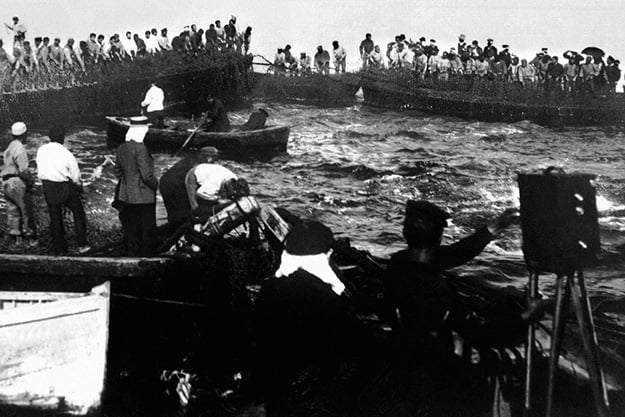
Tunny Fishing in Tunis
Chikly’s eye for composition is apparent in his still photography, but as a cinematographer he was also especially deft at coordinating movement. In Tunny Fishing in Tunis (1905), shown in a program of his nonfiction films from 1896 to 1914, his camera is mounted on a bobbing platform, one of several used to trap tuna. Men stand with harpoons all around the swaying enclosure, balancing themselves against the choppy water, and heaving giant fish into their boats. The sourced dolly is used in other films as well, a feat made all the more impressive given the cumbersome weight of cameras at the time. In his coverage of WWI, he placed the camera among the cars of an artillery convoy, showing close-up rows of large shells as they’re carried through the Verdun countryside. This shot was cut among distant views of explosions from the battlefield in Terre Sacrée (compilation d’images de la guerre) (1917-1918; “Sacred Ground (Compilation of Images of War)”) lending a sense of imminent danger amid the otherwise undisturbed landscape. In L’Offensive de Verdun du 20 Août 1917 (1917; “The Verdun Offensive of August 20, 1917”), Chikly’s camera is still, but placed at a midpoint in the trenches so that approaching soldiers rise up through the frame, their expressions captured in close-up along the way. Through his lens, we see images of war we’ve never seen before, then or since. In Les Marocains devant Verdun, Mars 1918 (1918; “Moroccans in front of Verdun, March 1918”) Moroccan soldiers don fezzes atop their gas masks; in L’Offensive de Verdun a dead horse lies half buried in the rubble, and, in one of the festival’s truly breathtaking moments on screen, soldiers strip on a beach in wide shot, then run to frolic in the sea.
The centennial program also featured a number of “diva” films, made at a time when films were just beginning to attract audiences for their star power. The diva showcase was particularly popular in the vibrant Italian silent cinema, and the outdoor screening of Assunta Spina (Gustavo Serena, 1915), featuring the charismatic Francesca Bertini, proved their enduring appeal, drawing a sold-out crowd. (Though I imagine many also came to see the spectacle of the carbon-arc projector—even the projectionist snapped a few shots of its billowing blue smoke—the rich tinting of the lightly worn original 35mm print, or the guitar and mandolin duo accompanying the film with traditional Neapolitan music.) Compared to the high theatrics and tempestuousness of a contemporary diva film like Pastrone’s The Fire (1915), the story of Assunta Spina is relatively low-key. Assunta, a laundress, must choose between her wrongfully imprisoned husband and the man who offers to steal her away. Bertini shines, having previously performed the role onstage; she accepted to do a film adaptation on the condition that she also direct it (though she goes uncredited). The real star, however, is the Naples setting, its shoreline making its way into more scenes than seemed necessary, and its waters making for the film’s most striking image, that of two silhouetted lovers floating away on a small boat. Another diva film set in Naples, The Dumb Girl of Portici (1915-16), directed by Lois Weber and Phillips Smalley from Universal’s Bluebirds Photoplay division (though the film was a Universal production), features Anna Pavlova as the fisherwoman Fanella who gets caught up in the 17th-century peasant revolt against a Spanish fruit tax. Pavlova is a broadly physical actor—her grins and grimaces don’t do much for her heroine’s tragic story—but as the free-spirited Fanella is especially given to dancing, her frantic twirling conveys something of the film’s historical turmoil. What’s unique are the two dreamlike dance sequences that bookend the film. In the first, Pavlova dances in white against a black background, lifted by a concealed partner, also in black, to create the effect of her floating. In the second, she pirouettes and rises among clouds that are superimposed over her, as if liberating her from the tumult below.
Bologna celebrated the 30-year career of Leo McCarey, for many years during Hollywood’s golden age the most sought-after director of comedies, with a program of his classics and rare shorts. As in Duck Soup (33), chaos tends to rule the day in McCarey’s films. Time and again, his characters get caught up in deceptions they’re forced to maintain, and in situations they’re decreasingly able to control. With the very funny and efficient short Sittin’ Pretty (24), a man impersonates a police officer to catch a car thief, but then gets called into a stakeout. Hijinks ensue: he accidentally volunteers to enter the murderer’s hideout, and in a gag made famous by Duck Soup, foils his enemy by mimicking his actions in a mirror. Improbably, he captures the murderer and wins the girl, but misses out on the reward. Even when ostensibly happy, McCarey’s endings are often only bittersweet. In Mighty Like a Moose (26), a husband and wife, unbeknownst to each other, each get plastic surgery, then seduce each other as strangers. The misrecognitions make excellent fodder for humor—at one point Charley Chase plays both the cuckolded husband and the new suitor as they chase each other through a hallway—but it’s impossible to shake the pall of doubt they cast.
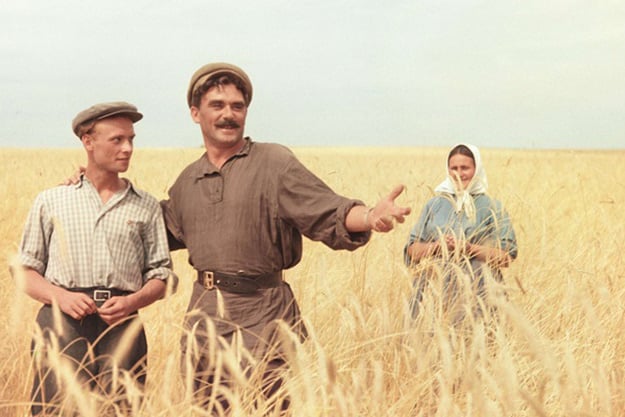
The Return of Vasili Bortnikov
Bologna’s grab bag made for some unexpected delights, including an agricultural theme running through a number of Soviet “early thaw” films of the mid-Fifties. In The Return of Vasili Bortnikov (53), Vsevolod Pudovkin’s final film, the business of collective farming is as important as the love triangle that, similar to Assunta Spina, develops between the soldier Bortnikov, presumed dead after the war, his abandoned wife Natalya, and the comrade who has filled his domestic shoes. In between moments of genuine pathos—as when Natalya admits to Bortnikov that she is confused about which man she loves, moves out, then gradually comes back to her husband—the kolkhoz workers fix tractors, plow fields, and install new machinery for milking and refrigeration. In one extended and genuinely moving sequence, the farmers sing a rousing song about tedding hay, and the music pauses when Bortnikov receives a letter and learns about his father’s death. For a moment, he sits against a flaxen wall and wipes away tears, then stands to rejoin the cheery crowd. The film was released only two and a half weeks after Stalin’s death, but the scene, and the film as a whole, suggests something of the change that was just beginning to happen in Soviet life. As the programmers Peter Bagrov and Olaf Möller put it in their introduction, there was “something different” in the air, a presentiment of the innovative stylistics of the next generation of Soviet filmmakers, here only barely suggested in the films’ attention to ordinary life and its slightest ambiguities.
Another film from 1953, Magdana’s Donkey, made by Georgian filmmakers Tengiz Abuladze and Rezo Čcheidze, shows how regional filmmakers enjoyed some degree of independence from the prevailingly sunny Soviet Realism style of the national studio. In stark black-and-white compositions of the rocky plains, and with observational detail reminiscent of Italian neorealism, it adapts a children’s story about a donkey. The beast (a decade before Bresson’s Au Hasard Balthazar, also showing in a newly restored print) is left half-dead on the road by a cruel merchant, rescued by a group of peasant children, nursed back to health and usefulness, then cruelly reclaimed by the merchant in a tsarist court. The village gathers and mourns, which from a Soviet perspective makes it a happy, if qualified, ending. An earlier film, Amassi Martirosyan’s Kurdy-Ezidy (33), which was screened as part of a series on Armenian cinema, also reflected the Soviet agenda as it played out in the farther reaches of the nation. Despite its overtly propagandistic story about ethnic Yazidi Kurdish villagers overcoming exploitation by local sheiks through a Soviet literacy program, the film preserves their customs in rich documentary detail, from the prayers done at dawn and sunset to the weave of scarves used in celebratory dances.
Attending a festival like Bologna shows that films are bridges to each other. The connections that may emerge in the course of a festival reveal continuities, whether intentional or not, sometimes within a single work. In Sohrab Shahid Saless’s A Simple Event (73), a landmark of the Iranian New Wave, it is possible to spot, or at least imagine, numerous influences in its aptly described simple, though no less devastating, story about the death of a boy’s mother. There are strains of neorealism in its delicate attention to the rhythms and repetitions of the family’s impoverished existence, and the spirit of Antoine Doinel in the young boy who does his best to win his parents’ affection. Shahid Saless studied cinema in Austria and Paris in the sixties, and he undoubtedly picked up on many European new wave currents before returning to Iran to make documentary films for the Ministry of Culture. Yet A Simple Event is also a stunning achievement on its own terms: a measured treatment of moments both large and small, and characters that express little outright, but whose implied anguish fills the screen. The influence of Shahid Saless on others can also be seen in the work of his Iranian New Wave peers. Abbas Kiarostami expressed particular admiration for A Simple Event, and he similarly adopted a child’s perspective as a way of describing social problems for Where Is the Friend’s Home? 14 years later.
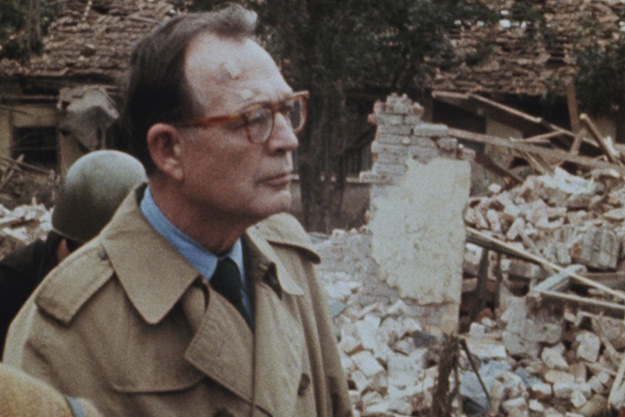
The Memory of Justice
Marcel Ophüls deals with the issue of legacy in ways both personal and political in The Memory of Justice (75), a sprawling four-and-a-half-hour documentary about the Nuremberg Trials, shown in a restored digital version. The film is engrossing, unpredictable and even at times punchy. For his interviews, Ophüls aimed both high and low, balancing footage of several high-profile Nazis that had been on trial, various lawyers, and concentration camp inmates who testified, with man-on-the-street questions as to the whereabouts of the convicted Nazi doctor Herta Oberhauer, and a discussion about the Holocaust among the fleshy patrons of a German sauna. At its best, the film produces a compelling sense of history, establishing a provocative link between WWII and the then-contemporary Vietnam War, two major events not usually conceived alongside each other, despite their historical proximity. The second part stresses this point, which is crystallized in one mind-boggling scene where Telford Taylor, the Chief Council for the US prosecution team at Nuremberg, stands next to Joan Baez in Hanoi, responding to a reporter’s questions about the bombing of a hospital. Through editing, Ophüls stages a number of memorable confrontations: between Taylor and Daniel Ellsberg, between the circumspect parents of a deceased Vietnam deserter and a stridently patriotic widow, between a German mother and her radicalized daughter, the Nazi hunter Beate Klarsfeld. Most powerful is the pairing of archival footage from the Nuremberg Trials with the account of Marie-Claude Vaillant-Couturier, a French resistance fighter interned at Auschwitz, who, after testifying, stared down Karl Dönitz, Albert Speer, and Hermann Göring as she walked past them. Despite the graininess of the black-and-white footage, the defiance of the then-young woman is electrifying.
Ambition unfortunately gets the better of Ophüls—there’s simply too much to tell, and the film’s focus loses coherence when it veers into the history of Native American extermination or the Algerian War. Some footage seems included only because Ophüls couldn’t resist a great story, as when we hear the admittedly amazing account by a French deserter about a six-day journey across the desert with an escaped prisoner. As a record of its own time, The Memory of Justice depicts a moment when all historical events seemed alive and connected, and Ophüls himself is right there, bespeckled and balding, eager to document it all. He was, unfortunately, unable to make it to Bologna for the screening. During the film’s introduction, programmer Cecilia Cenciarelli explained that she received a fax from him describing how he had gotten in his car with his dog and begun the drive to Italy. Then another fax came in: it was “too bloody hot” and he had turned around. “Maybe next year,” he said.



